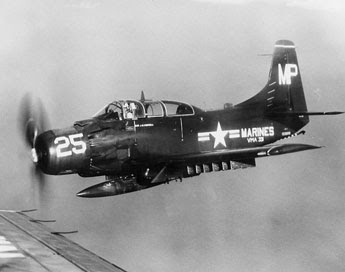*********************************
DOUGLAS A-1 SKYRAIDER
*********************************
INTRODUCTION: Would you believe that there was in World War II, a single-engine "fighter-type" plane, that could carry more ordnance than the multi-engine bombers---B17, B 25, and a number of others. It was the
*************************************************************************
Most of us little Clovis kids that grew up in WWII were simply inundated with the whole thing---constant war news on the radio, and early on---most of it bad. We soon were caught up in all kinds of drives for scrap material: paper, rubber, aluminum, tin foil, bacon grease, and stuff I can't even remember. Almost everything---gasoline, sugar, coffee, shoes, some clothes, candy, and chewing gum, and I don't know whatall--- was eventually rationed.
We boys were, as that war went along, interested in all the warplanes. We read "Dave Dawson in the R.A.F.," built model planes of all kinds, and watched, sometimes open-mouthed, as bombers of various kinds, endlessly droned around the outskirts of
All the boys had their favorite planes! I guess we all loved the B17, that tough four-engine bomber---the main
But many years later, long after WWII, I came to greatly admire a plane from that war---one that never fired a round in anger--that I know of during that war. It was the
DOUGLAS A-1 SKYRAIDER
INFORMATION//SPECIFICATIONS
(There were seven models; specs vary.)
ROLE---Attack aircraft
ORIGIN--- United States
MANUFACTURER---Douglas Aircraft Compnay
FIRST FLIGHT---18 March 1945
INTRODUCTION ---1946
PRIMARY USERS---
United States Navy
United States Air Force
Royal Navy
S. Vietnamese Air Force
PRODUCED---1945--1957
NUMBER BUILT---3,150
--------------
ARMAMENT--- Four 20 mm cannons; wide assortment of bombs, rockets, mines, grenades, flares, and gun pods; fifteen external hard points for ordnance
ENGINE---Wright R-3350, 18 cylinder, twin-row radials
MAX SPEED---325 mph
CRIUSE SPEED---198 mph
RANGE---1500 miles
SERVICE CEILING---28,500 feet
MAX TAKEOFF WEIGHT--- 24, 872 lbs.
WEIGHT EMPTY---11,965 lbs.
LENGTH---38 feet, 10 inches
WINGSPAN---50 feet
HEIGHT---15 feet, 8 inches
RATE OF CLIMB---2,850 feet per minute
----------------------------
CRIUSE SPEED---198 mph
RANGE---1500 miles
SERVICE CEILING---28,500 feet
MAX TAKEOFF WEIGHT--- 24, 872 lbs.
WEIGHT EMPTY---11,965 lbs.
LENGTH---38 feet, 10 inches
WINGSPAN---50 feet
HEIGHT---15 feet, 8 inches
RATE OF CLIMB---2,850 feet per minute
----------------------------
IMPORTANT FACTS TO KNOW
1. The lifting power of a
2. It was the LAST piston engine combat aircraft that was used by all our armed forces.
3. It was designed during WWII to meet Naval requirements for a carrier-based, single-seat, long-range, high performance dive//torpedo bomber. The plan was to use it to replace the older Hellcat and the Avenger. Prototypes were ordered on 6 July 1944, and it made its first flight 18 March 1945. As stated, it barely missed being used in WWII.
4. At least seven models//variations evolved over time, including two, three, and four-seat models. They were nicknamed in
5. For reasons not entirely clear to this writer, the workhorse Wright R-3350 twin-row radial engines in the A-1 were notorious oil burners---to the extent that the joke was---"It burns more oil in an hour than you car burns gasoline."
6. Though not designed for or capable of supersonic speed and air-to-air combat with jets, it is reported that an A-1 did down an enemy jet in the Viet Nam
7. The number of A-1 Skyraiders manufactured, 3,150, is a sizeable number when you consider that that number is about 20 plus % of the number of each of the B-17 and the B-24 totals manufactured in WWII.
*******************************
The plane came into it's own inViet Nam Viet Nam
Think how you might feel, in Viet Nam, 10,000 miles from home, your plane just shot out from under you, you bailed out and may have been injured and/or severely shaken up, and there you are---in a hot steaming 110 degree jungle with the enemy closing in around you. It would be nice to have an A-1 pilot making countless runs over your head, keeping you safe, until a copter team could arrive. Keep in mind that this A-1 pilot has probably done a good many dangerous missions like this before, he is a sitting duck up there, and he has a wife and kids back home that he'd like to see again too.
There are a number of good books out there on the A-1 Skyraider, all available from Amazon. "CHEATING DEATH," by Captain George J. Marrett is one of the best. He flew 188 rescue missions in the A-1, and finished his career as a test pilot, testing forty different military planes.
The plane came into it's own in
Think how you might feel, in Viet Nam, 10,000 miles from home, your plane just shot out from under you, you bailed out and may have been injured and/or severely shaken up, and there you are---in a hot steaming 110 degree jungle with the enemy closing in around you. It would be nice to have an A-1 pilot making countless runs over your head, keeping you safe, until a copter team could arrive. Keep in mind that this A-1 pilot has probably done a good many dangerous missions like this before, he is a sitting duck up there, and he has a wife and kids back home that he'd like to see again too.
There are a number of good books out there on the A-1 Skyraider, all available from Amazon. "CHEATING DEATH," by Captain George J. Marrett is one of the best. He flew 188 rescue missions in the A-1, and finished his career as a test pilot, testing forty different military planes.
*******30*******
BY MIL
1/24/13
Sent from my iPad



No comments:
Post a Comment